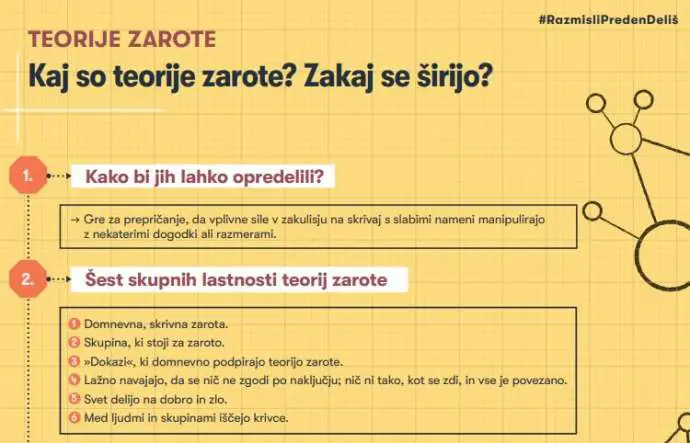Časoris is an online newspaper aimed at children. Each week we’ll take an article and post it here as a Slovene-English dual text.
Napotki Unesca: kako prepoznati teorije zarote
UNESCO guidelines: how to identify conspiracy theories
Written by Urban Sušnik, Sonja Merljak Zdovc translated by JL Flanner & G Translate
Ali lahko opazite teorijo zarote?
Can you spot a conspiracy theory?
Kaj menite na primer o tezi, da vesoljci usmerjajo politike? Ali da je Elvis živ? Da bele črte na modrem nebu zastrupljajo živa bitja?
For example, what do you think about the thesis that aliens direct politicians? Or that Elvis is alive? That the white lines in the blue sky are poisoning living things?
Teorije zarote tako kot lažne novice delijo družbo in povečujejo nezaupanje.
Conspiracy theories, like fake news, divide society and increase distrust.
V Unescu, vodilni organizaciji Združenih narodov, ki spodbuja medijsko pismenost, so pripravili navodila, kako jih prepoznati in kako se pogovarjati s tistimi, ki vanje verjamejo, pravi Barbara Urbanija iz slovenskega urada za Unesco, ki je poskrbela za prevod skupaj z organizacijo Most.
At UNESCO, the leading organization of the United Nations that promotes media literacy, they have prepared instructions on how to recognize them [conspiracy theories] and how to talk to those who believe in them, says Barbara Urbanija from the Slovenian office for UNESCO, who took care of the translation together with the organization Most.
Zakaj ste se odločili za prevod supercoil?
Why did you decide to translate the messages?
Lažne novice in teorije zarote so velika grožnja demokraciji in lahko povzročijo resnično škodo ljudem.
Fake news and conspiracy theories are a major threat to democracy and can cause real harm to people.
Veliko ljudi verjame v teorije zarote. Kar 60 odstotkov Američanov verjame v vsaj eno teorijo zarote; enako kažejo tudi javnomnenjske raziskave v Sloveniji.
Many people believe in conspiracy theories. As many as 60 percent of Americans believe in at least one conspiracy theory; opinion polls in Slovenia also show the same.
Tisti, ki so bili poučeni, kaj so teorije zarote in kako jih prepoznati, pa so zanje veliko manj dovzetni.
Those who have been taught what conspiracy theories are and how to recognize them are much less susceptible.
UNESCO in Evropska komisija sta se zato povezala s strokovnjaki in skupaj pripravila izobraževalne plakate (2, 3, 4, 5), ki so zdaj na voljo tudi v slovenščini.
UNESCO and the European Commission therefore teamed up with experts and jointly prepared educational posters (2, 3, 4, 5), which are now also available in Slovenian.
Kako so teorije zarote povezane z medijsko pismenostjo?
How do conspiracy theories relate to media literacy?
Bolj medijsko pismeni razumejo, kako delujejo mehanizmi teorije zarote, in se redkeje ujamejo v njeno past.
The more media literate understand how the mechanisms of conspiracy theory work and are less likely to fall into its trap.
Mladi se začnejo zanimati za teorije zarote okoli 14. leta, zato jih je treba pravočasno naučiti, kako se nanje odzivati.
Young people become interested in conspiracy theories around the age of 14, so they need to be taught in time how to respond to them.
Kako nagovoriti nekoga, ki verjame v eno od teorij zarote?
How do you address someone who believes in one of the conspiracy theories?
V pogovoru moramo biti predvsem sočutni in nikoli norčevalni.
In conversation, we must above all be sympathetic and never mocking.
Človek, ki verjame v teorijo zarote, je pogosto zelo prestrašen; prepričevanje v nasprotno verjetno ne bo imelo učinka.
A person who believes in a conspiracy theory is often very frightened; persuasion to the contrary is unlikely to have any effect.
Lahko pa ji prisluhnemo in postavimo podrobna vprašanja, da bo sama pomislila, ali so njeni argumenti res smiselni.
But we can listen to her and ask detailed questions so she can think for herself whether her arguments really make sense.
Read more stories and improve your Slovene at Časoris, while all our dual texts can be found here.







